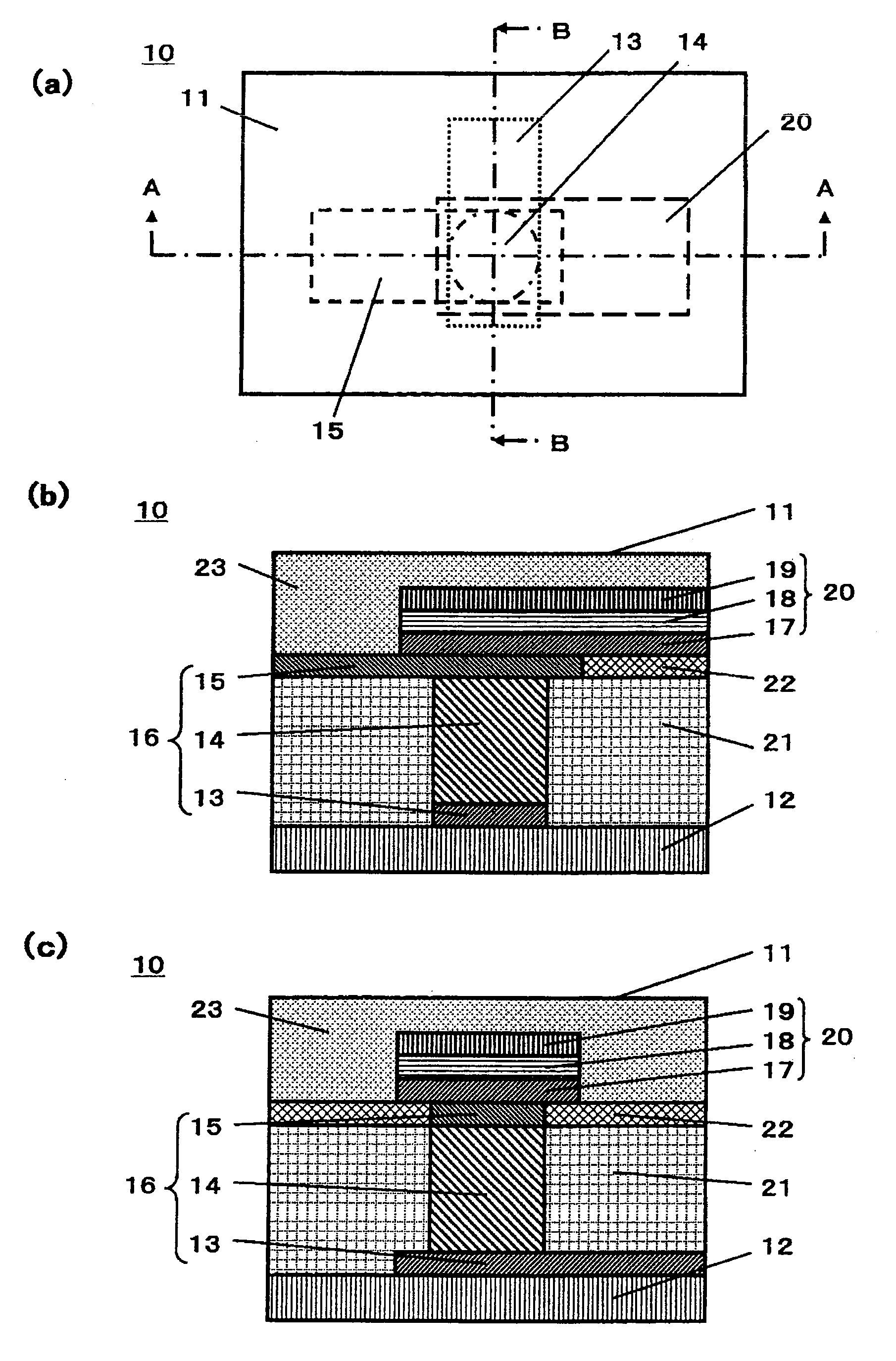Nonvolatile memory element, nonvolatile memory element array, and method for manufacturing nonvolatile memory element
a technology of memory elements and arrays, applied in semiconductor devices, diodes, electrical apparatus, etc., can solve the problem of not being electrically conductive, and achieve the effect of compact memory cell configuration, reduced resistance variable layer exposed to hydrogen atmosphere, and high current drivability
- Summary
- Abstract
- Description
- Claims
- Application Information
AI Technical Summary
Benefits of technology
Problems solved by technology
Method used
Image
Examples
embodiment 1
[0101]FIGS. 1 to 7 are diagrams showing Embodiment 1 of the present invention. FIG. 1 are schematic configuration diagrams of a nonvolatile memory element 10 of Embodiment 1 of the present invention. FIG. 1(a) is a schematic diagram showing a schematic configuration of the nonvolatile memory element 10 when viewed from a semiconductor chip surface 11. FIG. 1(b) is a schematic cross-sectional view taken along line A-A of FIG. 1(a) when viewed from a direction indicated by arrows A. FIG. 1(c) is a schematic cross-sectional view taken along line B-B of FIG. 1(a) when viewed from a direction indicated by arrows B.
[0102]In FIG. 1(a), a lower electrode 13 and an upper electrode 15 are disposed to sandwich a resistance variable layer 14 in a stack direction (thickness direction of the resistance variable layer 14; the same is true in the following explanation), and a rectifying element 20 is disposed on the upper electrode 15.
[0103]Moreover, as shown in FIGS. 1(b) and 1(c), the nonvolatile...
embodiment 2
[0138]FIGS. 8 and 9 are diagrams showing Embodiment 2 of the present invention.
[0139]FIG. 8 is a schematic configuration diagram showing the configuration of a cross-point type nonvolatile memory element array 40 when viewed from a semiconductor chip surface 31. As shown in FIG. 8, the nonvolatile memory element array 40 is configured such that the nonvolatile memory elements 30 of FIG. 2 are arranged as memory cells F in a cross-point manner. To be specific, in FIG. 8, the lower electrode 13 on the substrate (not shown) and the second electrode layer 19 having a stripe shape crossing the lower electrode 13 at right angle herein are configured to sandwich the resistance variable element 16 and the rectifying element 20. With this configuration, the write disturb is prevented, and in addition, the resistance variable element 16 can be driven by high current drivability. To be specific, the rectifying element 20 may be the MIM diode, the MSM diode, or the schottky diode. In this case,...
embodiment 3
[0150]FIG. 10 are schematic configuration diagrams of a nonvolatile memory element 45 of Embodiment 3 of the present invention. FIG. 10(a) is a schematic diagram showing a schematic configuration of the nonvolatile memory element 45 when viewed from a semiconductor chip surface 36. FIG. 10(b) is a schematic cross-sectional view taken along line I-I of FIG. 10(a) when viewed from a direction indicated by arrows I. FIG. 10(c) is a schematic cross-sectional view taken along line J-J of FIG. 10(a) when viewed from a direction indicated by arrows J.
[0151]In the present embodiment, unlike Embodiments 1 and 2, a metal wire layer is further formed on the second electrode layer 19 of the nonvolatile memory element 45 to extend in parallel with the second electrode layer 19. Thus, the wiring resistance of the second electrode layer 19 is practically reduced, and this realizes the increase in speed and the decrease in power consumption.
[0152]To be specific, as shown in FIGS. 10(b) and 10(c), t...
PUM
 Login to View More
Login to View More Abstract
Description
Claims
Application Information
 Login to View More
Login to View More - R&D
- Intellectual Property
- Life Sciences
- Materials
- Tech Scout
- Unparalleled Data Quality
- Higher Quality Content
- 60% Fewer Hallucinations
Browse by: Latest US Patents, China's latest patents, Technical Efficacy Thesaurus, Application Domain, Technology Topic, Popular Technical Reports.
© 2025 PatSnap. All rights reserved.Legal|Privacy policy|Modern Slavery Act Transparency Statement|Sitemap|About US| Contact US: help@patsnap.com



